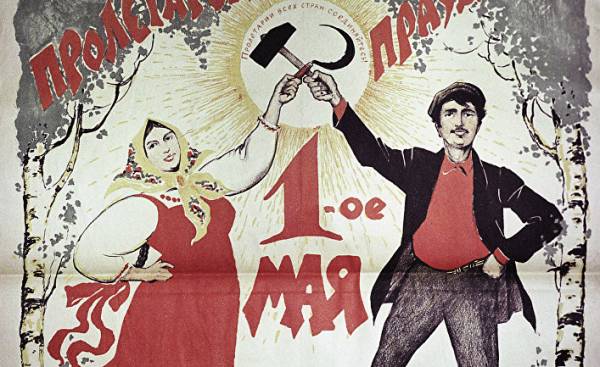
In the summer of 1922, the children’s librarian Ruth Epperson kennel (Ruth Epperson Kennell) left new York in a remote area of Siberia. She went there with her husband Frank and 132 “pioneers.” In Siberia they became members of the industrial colony of Kuzbass, as it was called utopian commune in the coal-mining city of Kemerovo. It was founded by “Big bill” Haywood, who became the leader of the Industrial workers of the world. In the US he was accused of spying, was released on bail at the time of filing an appeal and fled to Soviet Russia. Heywood and hundreds of other foreigners enthusiastically created industrial and agricultural communes, in an effort to help the “new Russia”. The kennel told me that the Kuzbass pioneers recreates the American settlement of the wild West and involved in the industrial development of the new region, not to build a new Atlantis, a “new Pennsylvania”.
By signing the two-year contract with the Society for technical aid to Soviet Russia and abandoning the comforts of the American middle class, kennel made a decision, which in those days was surprisingly popular. The article proletarian bard of Mike gold (Mike Gold) in the radical publication the Liberator, entitled “we Need pioneers for Siberia” (Wanted: Pioneers for Siberia) became the spark that sent the life of Kennesaw in a whole new direction. Gold wrote about the virtues of a mass Exodus, in which participants not only wanted to leave the U.S. these pioneers wanted to take part in the construction of something new. First and foremost, this applies to American women, who at that time received the right to vote, but the rest of their lives are not really changed. Appealing to the “young intellectuals who fled in the street of Paris coffee shop to savor cocktails there as a sign of noble protest against American Puritanism,” the gold in his article convinced Kennesaw to collect their belongings and go to Russia, leaving her son in the care of grandmothers.
In the early years in Russia voluntarily went mostly men, not women. And those women who were sent there, simply accompanied their husbands. However, the kennel went into that country not as a dependent and housewife, as working. In Kuzbass she was attracted by the fact that she will be able to avoid, as Lenin said, monotonous household work and will live on in the team.
It turned out that the kennel also dreamed of freedom from bourgeois morality. It increasingly attracted engineer from new York, whom she met in the office of the colony. When Ruth’s husband left because of a dispute between the “Industrial workers of the world” and the Communists, she felt relief, not regret. Kennel wrote in the popular satirical magazine American Mercury: “in the Spring of 1925 broke not one spousal partnership, usually on the initiative of the wife. In a Siberian penal colony women found the freedom he had dreamed of their souls.”
The kennel was one of the hundreds of American women who turned their attention on the revolutionary Russia, trying to find a new way of life. Before the Bolshevik revolution, suffragettes, the workers of the charities, supporters of prison reform, razoblachitelnoy social ills and other “new women”, concerned with the problems of social justice, joined the ranks of the fighters for “Russian freedom”. Many considered crucial efforts for the release of “the dark Russia.” The tsarist regime they had long been considered a “dark double” of the United States (he had the same “unstable” boundary and the tradition of serfdom, abolished almost at the same time, when America put an end to slavery). It seemed to them the embodiment of a centuries-old system in which the rich few brutally exploit the dispossessed masses. Lillian Wald (Lillian Wald) and other workers settlements with admiration wrote about the “gentle” revolutionary women in Russia, whose hatred of injustice made them take up arms and oppose the government. “New women” in the United States consenting to the Soviet attempts to socialize housework through the establishment of public laundries, canteens and nurseries. They praised the new ideal of “comradely love.” And they spoke positively about the laws that granted women the right to vote, legalized abortion, easier divorce proceedings and demanded equal pay.
By the end of 1920-ies of the hundreds of “American girl” among workers of charity organizations, journalists, teachers, artists and seekers of adventure “poured in the red capital,” to witness “a new life” and take an active part in it. The celebrated dancer Isadora Duncan came to Moscow in 1921 to open a dance school. She really wanted to see if there are any “country in the world that values mental and physical health of their children than commercialism”. Photographer Margaret Bourke-white (Margaret Bourke-White) in 1930 made his first trip to the Soviet Union, determined to capture the industrial progress in Russia. She said: “In Russia there is a lot happening, and happening at breakneck speed… the efforts of the 150 million people of enormous and unprecedented in history.” And in 1932 came to Moscow 22 African-American girls and African American, including famous figures of the Harlem Renaissance, such as Dorothy West (Dorothy West) and Langston Hughes (Langston Hughes) to play in movie showing “the first true picture of Negro life (in America)”. The picture was not removed, but the majority of the members of this group found in the Soviet Union a lot of what they admired. Some of them even stayed to live there.
Why is the rapture in revolutionary Russia, particularly among women, has been forgotten? Part of the answer lies in the fact that for many the “Soviet dream” turned into a nightmare, including for those hapless Americans who tried to establish their lives there. They undue optimism (and sometimes accidentally) have renounced us citizenship, and then found that he found himself trapped. Someone was sent to the Gulag camps, who died, and nearly all the rest of Russia has lost the idealism that attracted them there. Many have lived there for several years or months, that is quite enough to feel more than tourists, but too few to feel that their destiny is tied up with the Soviet Union. In many cases, these people considered possible to justify the violence, repression and paranoia, believing that this is a temporary and necessary phenomenon in the process of building true socialism.
But by the end of 1930-ies to justify all this was already very difficult, and when the cold war began, if not impossible. Today the “new cold war” became the prism through which we can look at the Russian Chapter in the history of American feminism. In the political sense, the story of the “American girls in red Russia” did not become useful in the past for the feminist movement, which has always been under siege. Kennel remained loyal to the Soviet Union until his death in 1977; but this is not a reason to admire it. However, this Chapter is actually useful in the sense that it allows us to understand something new about human desires and mistakes, the persistence of inequality between men and women, and on the belief that a better world is possible.
Russian Chapter in the history of American feminism reminds us that women’s struggle for balance between motherhood, family responsibilities and socially useful work, their desire for self-realization and equal romantic relationships, and their hopes for a more just society have a long and rich history. Today, when politicians and right-wing businessmen in Russia leads to selfish greed and its gross show of force, we should remember that in former times this country has attracted people with very different ideas and deeds.
Julie Mickenberg — associate Professor at the University of Texas at Austin, working in American studies. Her new book is called “American girls in red Russia: the pursuit of the Soviet dream” (the American Girls in Red Russia: the Soviet Dream Chasing).







